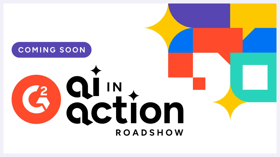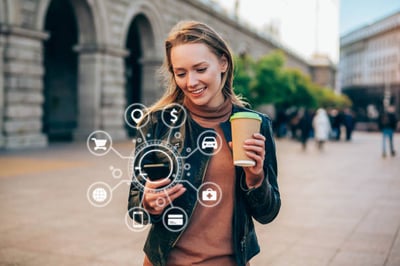April 28, 2025
 by Sidharth Yadav / April 28, 2025
by Sidharth Yadav / April 28, 2025

What’s common between Taylor Swift and B2B companies?
They both go all out in their fields to win over people’s hearts and nurture a fan base.
Take Swift’s Eras Tour, for example. It generated $2 billion in revenue and even benefited local economies. She created magic moments for fans everywhere.
“These are the examples I look at to seek inspiration for the B2B world,” says Kevin Lau, Vice President of Customer Engagement at Freshworks.
With the barrier to entry in software as a service (SaaS) lower than ever, he believes customers have more software options now, and they don’t hesitate to switch. You can’t take customer loyalty for granted anymore.
In a chat with me, Kevin shares what it takes to build an ecosystem of enablers within a company to turn customers into fans and boost retention. He also shares tips on creating magic moments for customers of AI products.
This interview is part of G2’s Professional Spotlight series. For more content like this, subscribe to G2 Tea, a newsletter with SaaS-y news and entertainment.
What's your favorite beverage? When do you enjoy it?
I enjoy boba, a kind of milk tea, with my family. It's usually a cold beverage, and you get to eat the tapioca balls in it.
What was your first job?
After I graduated from college, I started consulting. I wanted to create a social media business, and this was way before Twitter and Facebook.
I took a course and spent over $20,000 to learn the fundamentals of relationship marketing. Then, I started taking some clients. That’s how I got started before transitioning into the B2B world.
What's your favorite software in your current tech stack?
We use many different solutions. We use Base, which helps us reward, recognize, and curate customer engagement.
We also use UserEvidence, which helps us curate more personalized and relevant third-party validation from our customers. It addresses many of our pain points and provides evidence for our go-to-market (GTM) teams. Our team has found a lot of value in that software.
What problems at work make you want to throw your laptop out the window?
A lot of marketing folks would empathize with me when I say this: anytime you try to stitch data together and integrate systems, that can be a big challenge.
The same goes for finding the proper data to support or validate some of the campaigns or programs you’re building. These are the kinds of things that keep me up at night. It takes a lot of calories and cycles to determine how to best map that out, especially when we have various tech solutions.
Could you briefly describe your professional journey and what brought you to Freshworks?
Since my social media consulting days, relationship building, talking to customers, and hearing their validation and feedback have been important to me. I have been interested in questions like: how do we change the roadmap? How can customers be turned into fans, loyal users, and advocates?
I have worked with organizations ranging from large companies like Google to smaller startups in Silicon Valley. I’ve focused on how we build a thriving customer base and communities of passionate fans and followers.
I had a good stint at Marketo before the Adobe acquisition, which helped cement many of my learnings and practices.
Later, I joined Freshworks and saw many similarities with what Marketo was going through in its early days when it was trying to refine its GTM approach. They were tackling the questions of tapping into customer love and appreciation and harnessing it as a value differentiator for their business.
Freshworks is unique in the sense that it has a raving fan base. We have 70,000 customers globally, and we tap into customer experience professionals and people on the frontlines talking to support agents. They see those pain points and understand what it means to have a great customer experience.
On the other hand, our employee experience offering ensures employees have a great experience. These two philosophies stood out to me. I want to figure out how we can continue to do that right for our customers and internal teams and create a great organization.
How can companies more clearly see a strong link between customer engagement and revenue?
When we think of a healthy SaaS business, there are two sides to the equation. One side is focused on the lead generation pipeline. The other is concerning the post-sales experience — how do you ensure customers are satisfied?
Companies must balance those two sides because if you have a leaky bucket, with you getting new customers while some leave you, you need to figure out what’s causing that friction.
We’ve built a dedicated center of excellence at Freshworks around engaging customers across their journey from the time they evaluate solutions. This approach takes a holistic view of the customer journey rather than a partial one.
Our philosophy is creating customers for life and going beyond a transactional relationship with them. Even if the engagement is a year or two long, it aims to turn them into fans for life.
What’s the importance of customer fans to B2B companies? How can they use them to bring greater revenue?
Across the B2C world, iconic brands like Apple, Microsoft, or even sports teams all have fandoms where customers love products, individuals, or players. The products you market have inherent secret ingredients that make those engagements worthwhile.
“Another example is Taylor Swift’s Eras Tour, which brought her and local economies great revenues. The tour stood out because she engaged her fans and created magic moments for people both attending and not attending her concerts.”
Kevin Lau
Vice President of Customer Engagement, Freshworks
I look at such examples to seek inspiration for the B2B world.
Your offering may not be as exciting as the Eras Tour or an iPhone, but you would have customer fans who love your solution. It could be any solution, from HR tech to IT software.
You must harness those customers and offer them exposure, and you will end up with brand influencers. They love your product, so why not let them grow your business in the process?
Thank you for that elaborate answer. Customer churn is a major pain point for B2B companies today. Have the factors causing it evolved over the past few years?
After the pandemic, macroeconomic conditions changed, and so did GTM strategies. Companies are also undergoing digital transformation at a faster pace.
Businesses are also considering greater resource consolidation, streamlining to be more productive and efficient, and more closely scrutinizing their tech stacks.
“Today, there are way too many solutions out there. The barrier to entry in SaaS is lower now, and customers have more flexibility and options.”
Kevin Lau
Vice President of Customer Engagement, Freshworks
If they don’t have a great experience, they don’t hesitate to move on to another solution through a trial or a POC.
This means you can’t take customer loyalty for granted anymore. You have limited time to win over a customer, whether they’re new or old. You must treat them with respect and care, especially during the initial 90-day window.
The magic moments or raving experiences I mentioned help them see the value immediately. This could be achieved by showing them how to use the product faster, connecting them to loyal customers, or having them attend events. All of this ensures an impactful experience, so customers are less likely to churn.
You touched upon the increasing number of options in the market and how customers could switch quickly. According to G2 data, the AI product category is the fastest growing regarding the number of products being added. Do you have recommendations for retaining customers for AI products?
It goes hand in hand with onboarding, which I mentioned before. We have to meet the customer where they are. Most companies are in the evaluation phase for AI products.
They’re experimenting to see how AI can help drive better productivity and whether it’s the right solution to make employees successful. For example, with our Freddie AI product, we try to get customers through the beta process.
They can play with the solution in this phase and understand some use cases. This helps us gather validation and feedback before the product goes live in the general availability stage.
AI also has many applications in customer engagement. How is your team using AI to better customer experience and boost loyalty?
AI is helping us enhance support, which yields happier customers in the long term. It is helping us ensure our customers get answers to their questions, whether they relate to some pain points they’re trying to resolve with the product or simply want help. AI tools help us deflect tickets to ensure our customers see answers faster. We also use our online channels, including forums and group networks.
At the team level, we actively use AI for content creation, measurement, and data reporting.
How do you bring different functions in a company to work together on churn?
The biggest thing is to have a customer-first mindset. There’s an ecosystem at play that helps improve customer experience and create fans for your company.
Customers shouldn’t experience talking to different teams or functions in an organization. It should be a unified experience for them.
Apple is a good example from the ecosystem perspective. Even if you’ve had a bad experience with them once, the overall experience matters more.

Join industry leaders at G2's free AI in Action Roadshow for actionable insights and proven strategies to reimagine your funnel. Register now
Sticky moments across the customer journey hook you. Even in the B2B environment, customers view experiences from a similar lens. They may have had a rough onboarding experience or issues with the contract. But if they’ve had other great experiences, say from the support team, they would be willing to overlook minor infractions.
You’ve quoted examples from the B2C segment. How do the rules of engagement change between B2C and B2B? What are some of the engagement areas that are more important in B2B?
In B2B, the target is much more specific than in B2C, where you cast a wider net and your product is cheaper.
As a customer, you can buy a product using your credit card on an e-commerce website. However, in B2B, a customer goes through multiple sales cycles. You talk to engineers, pre-sales teams, and account representatives, and evaluate the product. You also involve multiple departments from your company. So, the buying behavior is different.
So, B2B is more about creating fans across different sectors of the buying company. It’s more like account-based marketing (ABM), wherein you don’t just talk to practitioners using the solution. You also engage mid-level influencers responsible for the cost center and the executives to show them value. This improves the likelihood of customers staying.
What are some of the most vulnerable spots along the customer journey where they are most likely to churn?
The onboarding experience is among the most critical junctures from a retention perspective. This is where the rubber hits the road, and the customer asks if the product delivers what the sales representative promised. They also ask whether they have the right tools and resources to see immediate value.
The second juncture is close to the renewal cycle. However long the engagement is, sometimes we wait too long to ensure we have the customer at the top of our minds. We wait until the renewal cycle to talk to them proactively and nurture them. Behind the scenes, they could be evaluating some other solutions.
With their autonomous capabilities, AI agents are changing how we work and build teams. Is the threat to humans real? Read our latest article.
Follow Kevin Lau on LinkedIn to unlock new ways of engaging customers and building a fan base for your company.
Sidharth Yadav is a senior editorial content specialist at G2, where he covers marketing technology and interviews industry leaders. Drawing from his experience as a journalist reporting on conflicts and the environment, he attempts to simplify complex topics and tell compelling stories. Outside work, he enjoys reading literature, particularly Russian fiction, and is passionate about fitness and long-distance running. He also likes to doodle and write about employee experience.
Engagement is everything.
 by M.Salim Dın
by M.Salim Dın
Can films inspire a startup idea?
 by Sidharth Yadav
by Sidharth Yadav
Forget everything you thought you knew about customer service. AI has changed the game...
 by Declan Ivory
by Declan Ivory
Engagement is everything.
 by M.Salim Dın
by M.Salim Dın
Can films inspire a startup idea?
 by Sidharth Yadav
by Sidharth Yadav


